The Bee Hummingbird is the world’s smallest bird and weighs less than a penny. This shows how delicate hummingbirds are. It also tells us why knowing their migration patterns is key. Changes in climate have changed when they come to North America. This brings challenges like different times for nectar plants to bloom and earlier springs.
As birdwatchers, we want to match our feeding plans with hummingbird migration times. This way, they find nectar when they migrate. By doing this, we make our backyards into places hummingbirds love to visit. It improves our chances of seeing these tiny birds. We’ll look at the best tips for watching hummingbirds, the best times to see them, and where to go.
Key Takeaways
- Hummingbirds’ arrival in North America varies based on regional climates.
- Climate change is affecting the timing of nectar plant blooms.
- Feeders should be set out early in alignment with migration schedules.
- Identifying key hummingbird hotspots can optimize viewing experiences.
- Understanding the best times to see hummingbirds enhances birdwatching success.
Hummingbird Migration Patterns Across the United States
Learning about hummingbird migration helps us bring these amazing birds to our gardens. Changes in climate and homes affect their usual paths. This change is important for those who watch birds.
Eastern United States
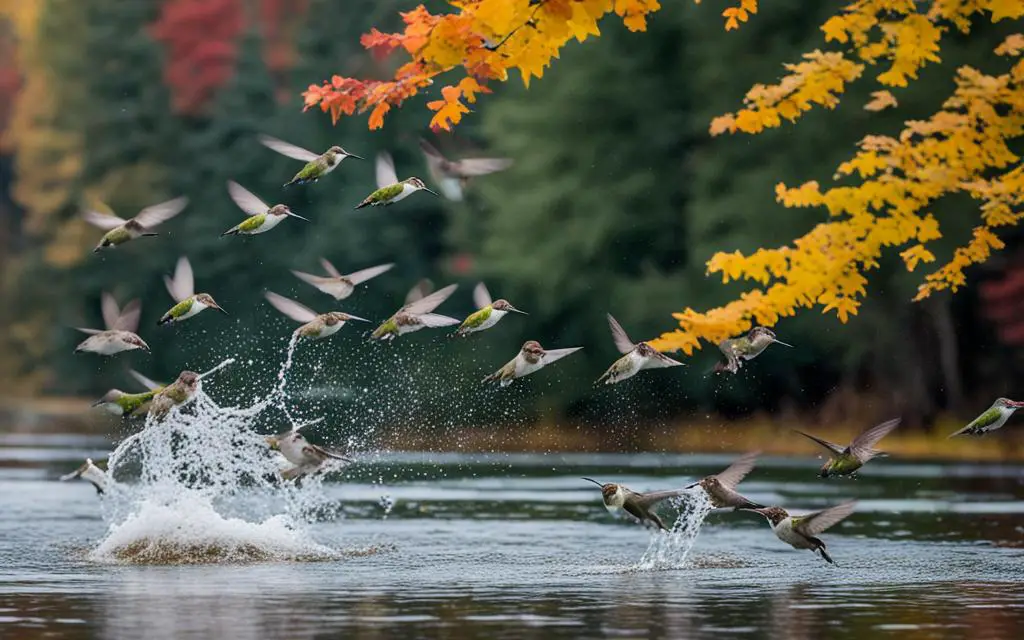
The journey of the Ruby-throated Hummingbird is incredible. They travel from Central America to the Eastern U.S. The weather getting warmer makes them leave earlier and stay longer near the Gulf Coast. To see these fast birds, put out nectar in early March in the Southeast. In the Northeast, do it in late April. This matches when they fly north.
Mountain West
Broad-tailed hummingbirds are often seen in the Mountain West. They fly through high places where it’s cooler. To invite them, plant local flowers that bloom from late spring to summer. This helps them during their journey.
Southwest and West Coast
Rufous hummingbirds make an amazing trip from Mexico to Alaska. They pass different areas and visit black-chinned hummingbird spots. To help them, put up feeders and plant flowers that grow in your area. Start in early spring. This gives them the energy they need to travel.
Hummingbird migration in the U.S. shows how tough and adaptable these small birds are. By knowing and supporting their travel paths, we can see them in our yards. We also help keep them safe.
Best Flowers for Attracting Hummingbirds
Want to make your garden a spot hummingbirds love? Choose the right plants. Knowing what plants attract hummingbirds is key to a great hummingbird garden.
Native Plants
Native plants are perfect for hummingbirds. They’ve grown up together. Look for trumpet creeper, bee balm, and cardinal flower. These flowers offer lots of nectar. They also help the local bugs hummingbirds eat during breeding time.
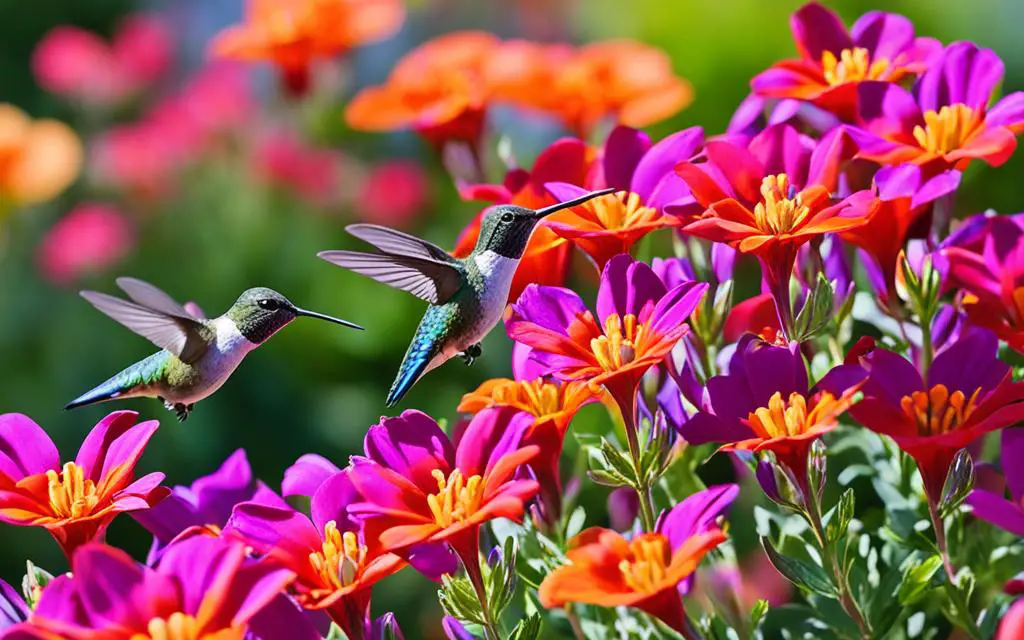
Top Annuals and Perennials
Mixing annuals and perennials keeps hummingbirds coming back. Salvia and fuchsia are great annuals. Perennials like columbine, penstemon, and red hot poker offer nectar all the time.
Maintaining a Healthy Hummingbird Garden
Keeping your garden hummingbird-friendly is important. Water, prune, and get rid of dead flowers. Stay away from pesticides. Adding feeders with nectar makes your garden even better.
Use native plants, annuals, and perennials together. Take good care of them. This way, you’ll have an amazing garden that hummingbirds visit often.
Hummingbird Seasonal Guide for Birdwatchers
Every birdwatcher should track hummingbird behavior through the seasons. Knowing their patterns lets us give them the best care all year long.
Spring Sightings
Hummingbirds reappear in spring, marking breeding season’s start. The first sightings are important, urging birdwatchers to get gardens and feeders ready. This helps attract these colorful birds early by providing lots of nectar.
Summer Activity
In summer, hummingbirds’ feeding habits become clear. Thanks to many flowers and bugs, they stay very busy. Watching them during summer lets us see their unique feeding ways and make sure our gardens have what they need.
Fall Migration
Fall means it’s migration time for hummingbirds. Knowing their migration patterns in fall helps us get ready by keeping feeders full longer. This helps ensure the birds have enough to eat on their way south. It’s exciting to see different kinds flying through.
Winter Range
In winter, hummingbirds move to warmer places. Those in milder areas can keep watching these birds during this quieter time. It’s important to keep feeders clean and full, so they have enough food when it’s cold.
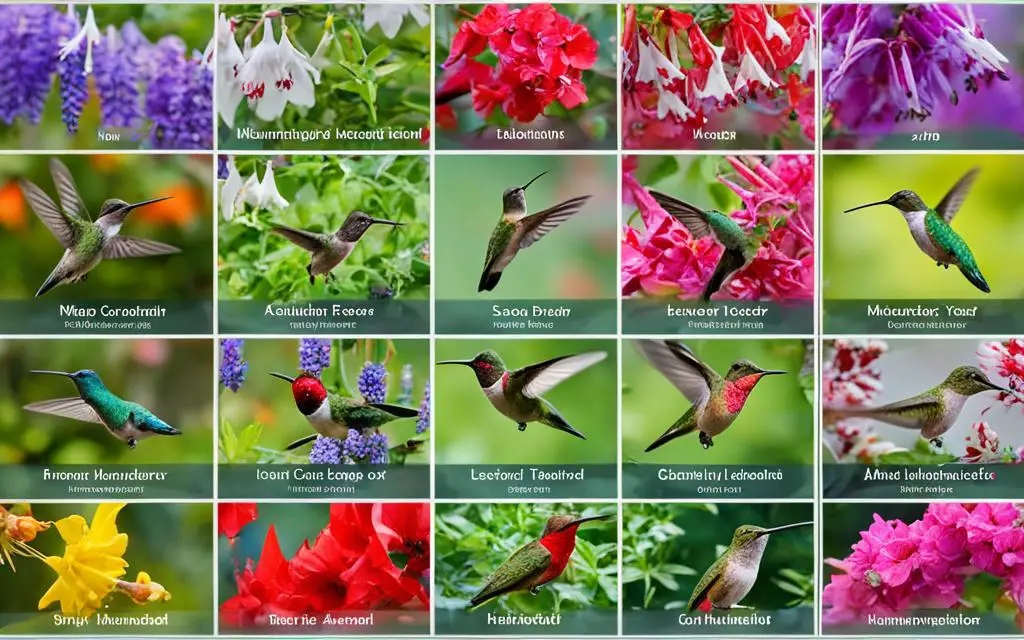
Tips for Creating a Hummingbird-Friendly Garden
To make a garden where hummingbirds love to visit, do more than just plant flowers. You need a place with nectar, water, and the right care. This makes a perfect home for these wonderful birds.
Nectar Feeders and Maintenance
Putting up nectar feeders and keeping them clean is key to draw hummingbirds. Always clean the feeders well to stop mold. Also, fill them with fresh nectar regularly. Doing this keeps a steady food spot for the hummingbirds, so they return often.
Water Sources
Hummingbirds need water, not just nectar. A small birdbath with a soft mist attract them. This turns your yard into a place where hummingbirds can drink and bathe without worry.
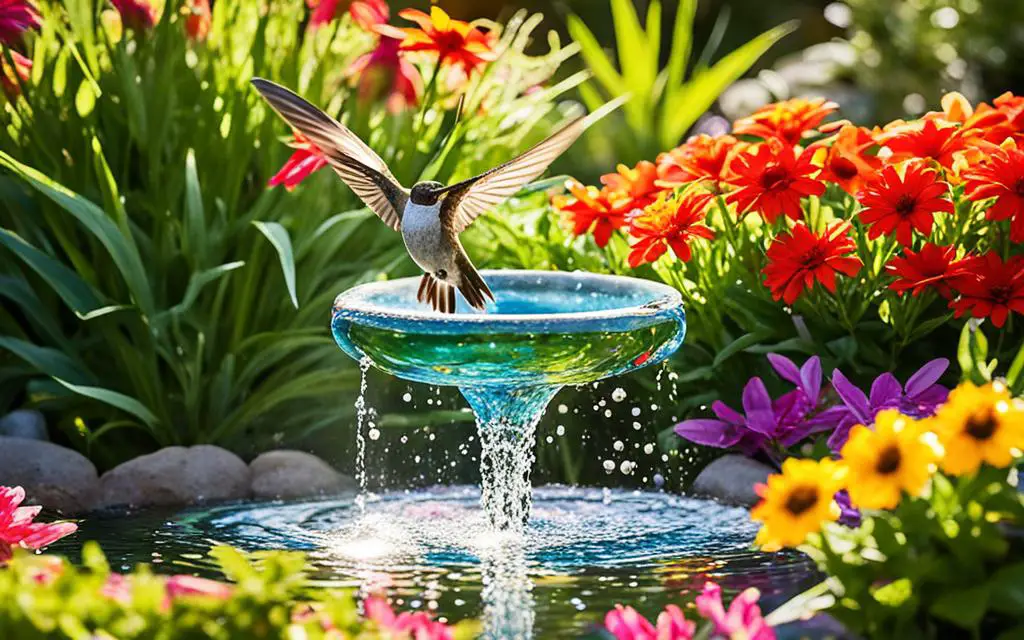
By adding all these parts, we make a perfect spot for hummingbirds to live well. These garden tips help ensure our bird friends have everything they need.
| Nectar Feeders | Water Sources |
|---|---|
| Regular maintenance | Shallow birdbaths |
| Fresh nectar | Misting features |
| Consistent placement | Clean water |
| Mold prevention | Safe accessibility |
Conclusion
Hummingbird watching is more than just fun. It helps these amazing birds live better lives. By following their travel patterns and making our gardens welcoming, we help hummingbirds. They rely on us to make safe places for them, especially when the environment changes.
It’s also key to join in on saving hummingbirds. Taking part in science projects, like those from Audubon, is one way. This helps us learn about how many hummingbirds there are and where they go. Helping with hummingbird research gives us a chance to save them for the future. Being part of hummingbird festivals brings people together who want to keep these birds safe.
Our work keeps hummingbird places safe and supports important studies on them. Let’s use what this guide says to watch birds better and help them. If we do this together, we can make sure hummingbirds stay around for many years.
Source Links
- https://www.audubon.org/news/when-expect-hummingbirds-your-yard-spring
- https://www.hummingbirdcentral.com/
- https://www.explorelawrence.com/blog/post/a-seasonal-guide-to-birding-in-lawrence-spring/

My name is Shane Warren, the author behind Your Bird Buddy – your ultimate guide to the wonderful world of birds! Unleash your inner avian explorer as we delve into a vibrant library of knowledge dedicated to all things feathered. From learning about diverse bird species from across the globe to understanding their captivating habitats and behaviors, I’m here to fuel your passion for these magnificent creatures. Not only that, but I also provide valuable insights on being a responsible and informed pet bird owner. Join our vibrant community and let’s celebrate the feathered wonders of the world together – one chirp at a time. And be sure to join our Your Bird Buddy Community over on Facebook!

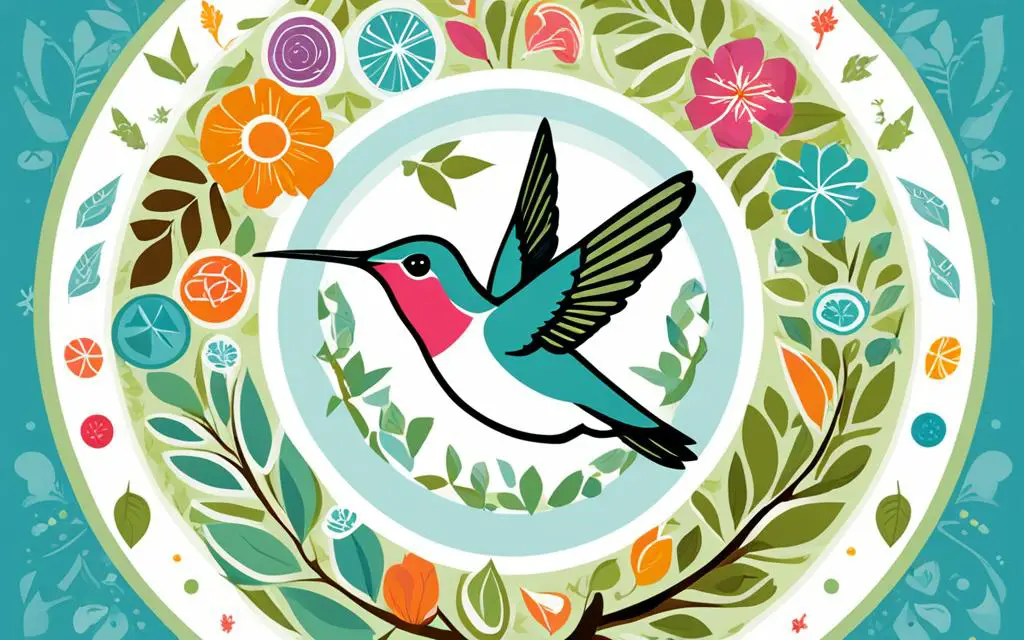
Comments are closed